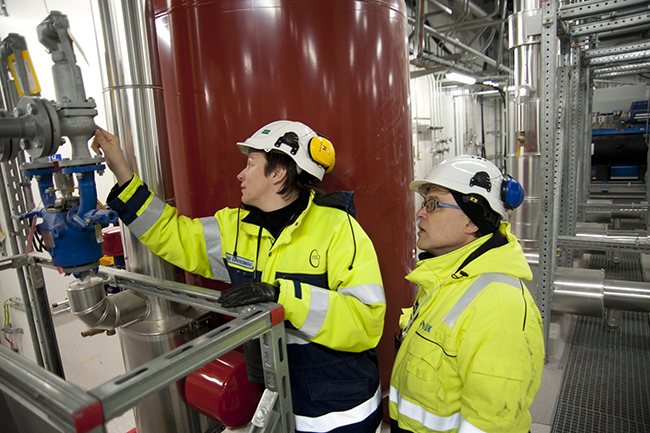Precision is the key in commissioning of OL3 systems
28.4.2016
The commissioning tests of the process systems started at the Olkiluoto 3 plant unit on 6 April with the testing of the service water system essential service water piping system. Many things need to be just right before commissioning can be started.
| Commissioning phases: Phase A: Component and system tests Phase B: Overall system tests - cold functional tests - hot functional tests I Phase C: Fuel loading and hot functional tests II Phase D: First criticality, nuclear overall plant tests at various power levels and plant performance test Phase E: Plant Demonstration Run |
Approved documentation is the basic requirement
Commissioning is not started until all the documents associated with the object and the approval status of the documents have been carefully checked. All documentation must be in order, including design documents, system commissioning programmes, piping stress analysis, fatigue analysis, protocols of installation inspections as well as instructions for equipment operation and maintenance.
– There must be no open points that prevent the start of commissioning. For this reason, it is important that the availability and validity of all the approved documents is verified during the preparatory phase, explains Heidi Lähdesmäki, Deputy Commissioning Manager at TVO.
TVO has some 120 experts working in the commissioning process, each with a specific responsibility area. The number of people needed to verify that everything is ready for testing depends on the object to be commissioned.
Cooperation with the plant supplier's personnel works well.
– We have our desks in the same work area. Thanks to that, we can deal with matters efficiently, Ms. Lähdesmäki concludes with satisfaction.

Heidi Lähdesmäki visiting the OL3 worksite together with Lasse Kuosa, who is a local inspector of the Radiation and Nuclear Safety Authority in Olkiluoto. They are in the turbine island to inspect the name plate of registered pressure equipment and the associated safety valve as part of the first phase of the commissioning inspection.
Exact test plans
For the most part the commissioning phase is implemented separately for the nuclear island and the turbine island. Later testing proceeds to joint functional tests of multiple systems and the final objective is a reliable and safe plant unit that has been approved for full reactor power operation.
According to Ms. Lähdesmäki, the most important commissioning phase is the second phase, or phase B, which covers the joint functional tests of the systems.
– By the time the commissioning inspection of the first phase is carried out, mechanical, electrical and I&C aspects need to be shaking hands with each other. If we cannot supply power to the pump or the pump's brain does not function, the pump is useless. The second phase is about joining forces and showing a clear direction forward.
When the testing phase is about to start, the system commissioning programmes prepared for each system and different equipment groups are in a key role. They describe what is to be tested and how, as well as the acceptance criteria for the tests. The system commissioning programmes comprise tests carried out at the various commissioning phases. Some of the commissioning tests are completed within phase A, while other tests go on up till phase D. The execution depends on the connections between the system to be tested and other systems.
– About 170 commissioning programmes concern the nuclear island, and about 70 the turbine island. A system commissioning programme can cover several systems. The total number of equipment unit at the plant is about two hundred thousand, Ms. Lähdesmäki clarifies.
The plant supplier is responsible for the commissioning of the plant, but TVO's commissioning engineers are involved in the commissioning tests in a supervising and controlling capacity. The supervision of the tests provides them with valuable knowledge about the operation of the systems. Cooperation with the inspectors of the authority, i.e. the Radiation and Nuclear Safety Authority, is also smooth.
- The common goal of all the parties is to verify that the plant systems and all system components are tested in accordance with the system commissioning programmes with acceptable results. This way we can together achieve the specified performance requirements and verify that the operation of the plant unit is safe, Ms. Lähdesmäki sums up.
Share